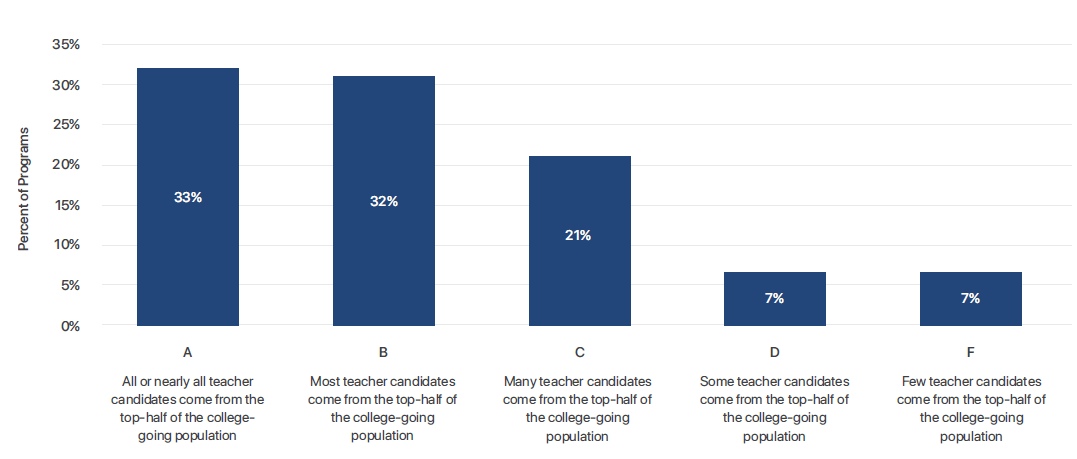Evaluation of undergraduate programs relies on four sets of data:
Mean university SAT/ACT scores sourced from the Integrated Postsecondary Education Data System (IPEDS)4
Barron's selectivity ratings (in the absence of data on SAT/ACT scores) sourced from Barron's Profiles of American Colleges5
Minimum GPA and admissions test requirements sourced from the undergraduate catalog or admissions requirements webpage6
Mean GPA for the most recently admitted cohort of teacher candidates provided by the program7
Evaluation of graduate and non-traditional programs relies on two sets of data:
Minimum GPA, admissions test, and audition requirements sourced from the graduate catalog or admissions requirements webpage8
Mean GPA for the most recently admitted cohort of teacher candidates provided by the program9
Institutional characteristics -- median SAT and ACT scores and Barron's ratings -- are collected for each institution, where available. Separately, a team of analysts use course catalogs and program admissions webpages to determine the admissions requirements specific to the teacher preparation program.
For undergraduate programs, which typically admit teacher candidates in their junior year, we identify the minimally acceptable GPA to enter the program. Acceptable thresholds for graduate and non-traditional programs can be either a candidate's overall GPA or that of upper division coursework only. In instances where a program sets both unconditional and conditional GPA thresholds, separate measures for different segments of undergraduate coursework, or other variations where there are multiple minimums, we use the value that applies to all coursework and serves as the floor for all admitted candidates.
Example of conditional admission: Candidates must submit "official transcript(s) indicating a minimum grade point average (GPA) of 3.0 on a 4.0 scale of all undergraduate and post-baccalaureate coursework combined," but then allows conditional admission on the under the criteria that "Applicants who do not meet the minimum GPA requirement of 3.0 will be required to successfully complete a full 500-600-word writing sample." Since a 3.0 GPA is not a true floor for admissions, the program would not receive credit for the unconditional requirement.
Example of segmented requirements: Candidates must have either "a cumulative grade point average (GPA) of 2.75 or a GPA of 3.0 over the two most recent semesters." We would use the 2.75 figure in this case since it reflects the more universal requirement.
Example of multiple minimums: Candidates must submit a transcript demonstrating "a cumulative undergraduate GPA of 3.0 or a GPA of 2.8 for all upper division coursework." This program would be noted as requiring a 2.8 GPA since it is the lower baseline under which candidates can be admitted.
Both undergraduate and graduate programs are invited to share the certified GPA of their most recent cohort of admitted students. When provided, these figures are considered on a separate, more demanding scale from the minimum GPA values because, while this mean value is a representation of the strength of the admitted candidates, it does not ensure that all candidates possess a GPA above the program minimum.
In addition to collecting GPA requirements for undergraduate programs, analysts also identify any SAT or ACT admissions requirements set by the program. For graduate and non-traditional programs, we catalog any graduate-level admissions test requirements (GRE, MAT) and the details of any audition process. These standardized tests that are normed to the entire college-going population are only considered to be requirements in cases where candidates cannot bypass a passing score with an alternative measure (GPA, basic skills test, personal statement, etc.)
Once these data are collected, as detailed under the Scoring Rubric, undergraduate program grades are determined by the highest achieved criteria, while graduate and non-traditional program grades are derived from the sum of the GPA and candidate screening measures.





